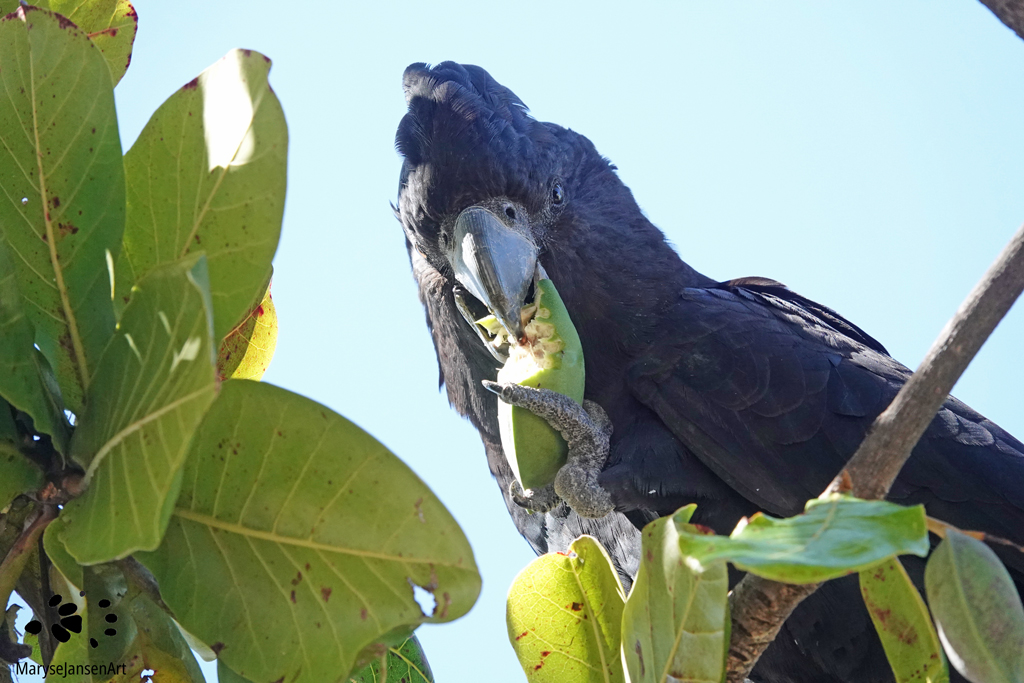Bird Photography by marysejansenart
A unique opportunity for a close encounter
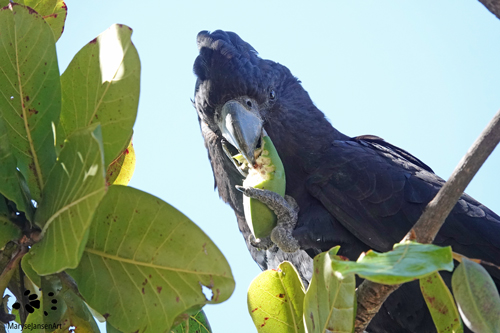
Table of Contents
A close encounter
A soft screechy noise attracts my attention. Next to me is a large tree with big leaves. Hidden between those leaves and branches I find some Red-tailed Black-Cockatoos feeding on the fruit of this tree. Wow! I can’t believe I am so close to these awesome birds! Usually they are quite shy of people and will take off with a loud screech before you get the chance to come anywhere near them! On all other occasions that I’ve spotted them I have only seen them from a distance: on the tops of high trees or in flight. But right now, they seem very content munching on the large fruits so I take my chances to get some good photos!
The Red-tailed Black-Cockatoo (Calyptorhynchus banksii) is one of six species of Black-Cockatoos and it is the most widespread one. Five subspecies are defined and they are recognised by slight differences in body size, shape and size of their beak and the colouring of the females. I am currently in North Queensland and looking at the subspecies Calyptorhynchus banksii banksii, which is the largest subspecies in body size, has a moderately sized beak and is found mainly in northern Queensland. Occasionally you may spot them in south-east Queensland and northern New South Wales, but they have mostly disappeared from these areas.
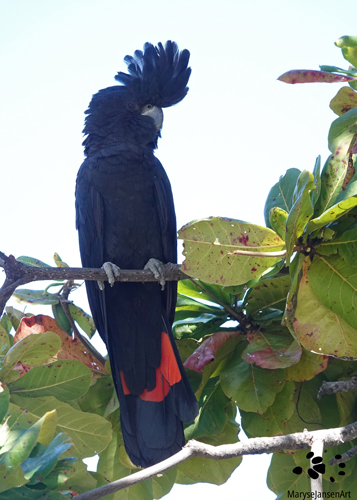
Red-tailed Black-Cockatoo looks and habitat
Male birds are all black, except for the bright red panels in their tail that give them their name. You can see this in the image above. Females are black with yellow spots and have orange-yellow panels in their tail. You can see a female in the image below.
All Red-tailed Black-Cockatoos are found in woodland habitats, mainly across a wide band in the northern parts of Australia and also in some isolated patches in more southern parts of the country. They are not migratory but do have a nomadic lifestyle, following the food sources that are available during different seasons. Their main staple is Eucalyptus seeds. Further, they consume seeds of other trees such as Wattles, Banksias, Grevilleas and She-oaks. Their diet is complemented with grains, berries, fruits and insects.
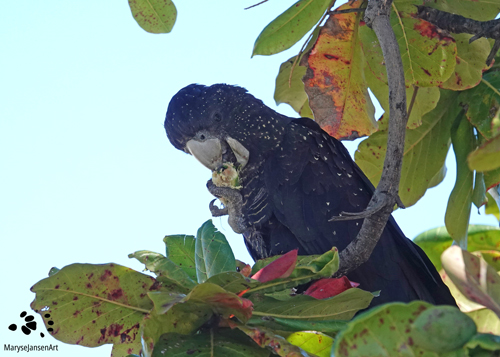
The fruit of the Beach Almond Tree
Right now, they are munching on the fruit of the Beach Almond Tree. This is a large tropical tree that grows locally along the coast of north Queensland. It is also known as the Sea Almond Tree. The tree grows a crown with wide horizontal branches and is an ideal shade tree. It is one of the very few trees in the tropics that lose their leaves during winter. As it currently is winter I can indeed observe a lot of the leaves changing colour from a glossy, dark green to a deep red and some are falling on the ground.
The fruit of the Beach Almond is a stone fruit of about 6cm long and 4.5cm wide. It is currently green, so not ripe, but the Cockatoos don’t seem to mind. When ripe, the fruit turns red. The fruit is quite stringy, it’s difficult to separate from the stone and tastes a bit like almonds.
The Cockatoos have feet with two toes facing front and two toes facing backward. This allows them to hold the fruit firmly with one foot while holding on to the branch they are standing on with the other foot. With their strong bill they can pull the fruit apart. They eat the good bits and drop the rest on the ground. Enjoy the short video below to see this in action.
Breeding behaviour
Red-tailed Black-Cockatoos choose tall trees for nesting. The trees may be dead, but need a trunk with a large diameter, because the birds need large hollows to nest in. The hollows can be 1-2 metres deep and up to half a metre wide. Eucalyptus is usually the favoured type of tree and the birds prefer it to be isolated so that they have easy access to the nest. The cockatoos chew the inside of the hollow to create woodchips and wood dust to line the nest with.
Usually, the cockatoo lays one egg. Sometimes two, but generally only one of the two chicks will survive because the weaker one will be neglected. The female incubates the egg (or eggs) and while she’s brooding the male will feed her. Both the male and the female feed the chicks. The little ones are born with a yellow down. As their feathers begin to grow they look a lot like the female bird. After four months they are ready to fledge, but they stay with their parents for a much longer time.
At four years of age the young birds reach puberty. The maturing process which will give them their adult male or female plumage takes about another four years. Cockatoos can live quite long, up to a couple of decades in the wild. In captivity, birds of 50 years have been reported. Red-tailed Black-Cockatoos mate for life.
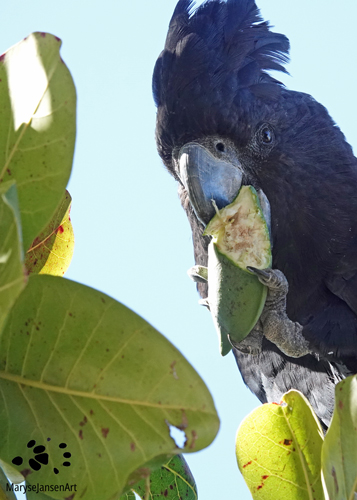
If you are interested in purchasing the featured image ‘Red-tailed Black-Cockatoo Male Feeding’ or would like to see what the image looks like on the various products, please head to my shop. Or, for the other images in this post, check out my Collection of Australian Parrots here.
To read more stories about other Australian Parrots, click here.

